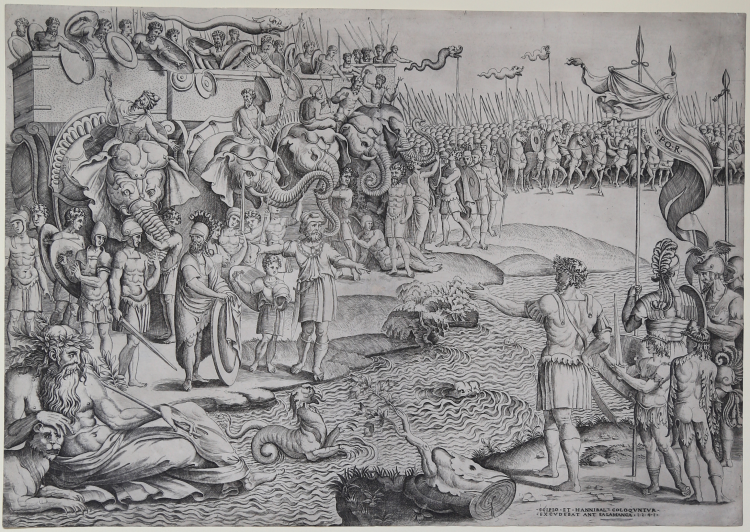



| Reference: | S30313 |
| Author | Marco DENTE detto "Marco da Ravenna" |
| Year: | 1521 ca. |
| Measures: | 552 x 391 mm |


| Reference: | S30313 |
| Author | Marco DENTE detto "Marco da Ravenna" |
| Year: | 1521 ca. |
| Measures: | 552 x 391 mm |
Engraving, around 1521-23, after a subject attributed to Giulio Romano. Example in the first state of three (or the second of four according Massari), with the address of Antonio Salamanca and the date 1541.
Magnificent example, rich in shades, printed on contemporary laid paper with watermark "crossbow in the circle with lily" (760 Briquet, paper dating from the first half of the sixteenth century), trimmed to copper, in excellent condition.
The engraving depicts the meeting between Hannibal and Scipio, before the battle of Zama, during the Second Punic War, which took place in 202 BC, according to Tito Livio. (Stories, XXX 29 and 30. 1-2).
On both sides of the river, personified by a deity crowned, bottom left, on the right are Scipio, accompanied by two standard-bearer and two boys; on the left, Hannibal, with his army, elephants and cavalry.
The subject corresponds to the twelfth scene of the tapestries cycle Gesta of Scipio.
In July 1532, François I ordered a gigantic ensemble of twenty-three-panel tapestry depicting the heroic deeds and ultimate triumph of Scipio Africanus. The whole set was completed in April 1535, and comprised two cycles: following an introductory allegory, 12 illustrate the Deeds of Scipio, based on Tito Livio, and largely designed by Giovanni Francesco Penni; and 10 scenes of the Triumphs of Scipio, based on the description of the historian Appiano.
"Scipio the Great", finely woven and particularly rich in gold threads, was widely admired and copied several times. During the Revolution, the panels were sold and dispersed. In 1797, François I's tapestry was burned along with other tapestries from the Royal Furniture Repository in order to recover the precious metals.
The petits patrons, the original drawings, for 15 of the compositions, have survived.
The 'petit patron' for this section of the tapestry is preserved in the Louvre, inv. no. 3719.
There is a related sketch in the Bibliotheque Nationale, Paris, Réserve B5, attributed earlier to Giulio Romano (Heinecken, Huber, Zanetti e Passavant) but more recently to Giovanni Francesco Penni.
On the basis of the differences between the Louvre drawing and the print, Stefania Massari in Rome 1993 supposes the direct model for the engraving was possibly a copy of this, today lost. The inventor of the composition had been debated, but Massari argues for Giulio Romano's authorship.
It is documented that the plate was later in the possession of Carlo Losi, therefore Massari lists a hypothetical fourth state with his publisher's address.
Massari lists also an hypothetical first state too, before the Salamanca’s address.
Ex collection Staatliche graphische Sammlung München(Lugt 1613).
Magnificent example.
|
Bartsch XV, 30.5; Heinecken, I.648; Huber, III, 102.3; Massari, Giulio Romano pinxit et delineavit, pp. 42-44, n. 38; Oberhuber, Roma e lo stile classico di Raffaello, pp. 208-209; Passavant, VI.72.63. Dimensioni 552x391.
|
Marco DENTE detto "Marco da Ravenna" (Ravenna 1496 - Roma 1527)
|
The right name of this artist was Marco from Ravenna, not Silvestro as erroneously many people say due to the monogram RS, which has to be interpreted as ravenates sculpsit or sculptor. He came from a rich family of Ravenna, where he was born in 1493; he afterwards died in the Sack of Rome in 1527, as Zani says.
He went to Rome very likely in 1510 to work inside Baviera’s workshop, together with Marcantonio and Agostino Veneziano. In Rome, the artist from Ravenna, besides engraving the most beautuful examples of classical statuary, mainly devouted himself to the reproduction of Raphael’s drawings, as his collegue Raimondi.
Marco can be condidered a very uncommon artist, for he was the first to renew the school of Marcantonio, with “fully pictorial” prints.
Bartsch ascribes to him sixtytwo subjects, while Passavant says are sixtyfour.
|
|
Bartsch XV, 30.5; Heinecken, I.648; Huber, III, 102.3; Massari, Giulio Romano pinxit et delineavit, pp. 42-44, n. 38; Oberhuber, Roma e lo stile classico di Raffaello, pp. 208-209; Passavant, VI.72.63. Dimensioni 552x391.
|
Marco DENTE detto "Marco da Ravenna" (Ravenna 1496 - Roma 1527)
|
The right name of this artist was Marco from Ravenna, not Silvestro as erroneously many people say due to the monogram RS, which has to be interpreted as ravenates sculpsit or sculptor. He came from a rich family of Ravenna, where he was born in 1493; he afterwards died in the Sack of Rome in 1527, as Zani says.
He went to Rome very likely in 1510 to work inside Baviera’s workshop, together with Marcantonio and Agostino Veneziano. In Rome, the artist from Ravenna, besides engraving the most beautuful examples of classical statuary, mainly devouted himself to the reproduction of Raphael’s drawings, as his collegue Raimondi.
Marco can be condidered a very uncommon artist, for he was the first to renew the school of Marcantonio, with “fully pictorial” prints.
Bartsch ascribes to him sixtytwo subjects, while Passavant says are sixtyfour.
|